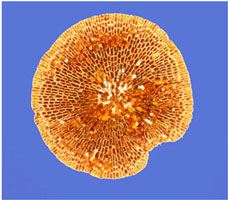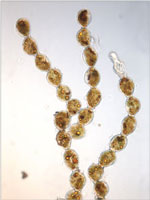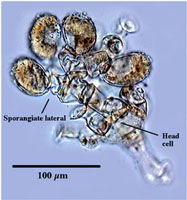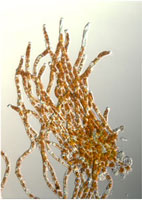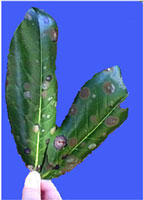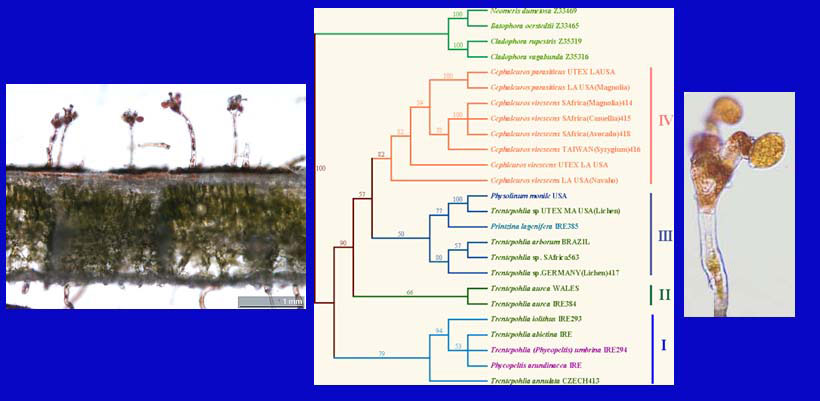
The Trentepohliales lineage left its kin behind in the seas and became one of those successful colonizers now surviving well in its terrestrial home. The green algal order Trentepohliales offer a current example of life forms dealing with new ecological factors in a new environment: the subaerial habitat. They may provide the keys to understand the struggles and solutions that primordial photosynthetic forms went through in order to conquer the land and become the most notable feature of our planet. Their cell division (phragmoplast-mediated cytokinesis) is similar to that of higher plants. The fact that this complex and sophisticated mechanism has evolved separately in these two different lineages of green plants shows that the Trentepohliales are an ideal group to illustrate the adaptations required for the colonization of terrestrial habitats.
The Trentepohliales are also an algal group of considerable practical importance, several species of the genus Cephaleuros are known to produce or facilitate infections, injuries, and necrosis (“red rust”) on tea, citrus, coffee and other important cultivars. The trentepohlialean algae are also found as participants in a lichenic association with fungi, the genera Strigula, Raciborskiella, Racodium and Coenogonium are some generic examples of lichens with a trentepohlialean phycobionts. They have been used as ecological indicators of pollution and producers of chemicals with biotechnological applications. Given their overabundance in tropical and temperate regions with humid climate they are often a considerable practical nuisance, agents of aesthetic and mechanical biodeterioration of human construction from housing to art sculptures. Since their geographical distribution is strictly linked to regions with precise climatic traits (i.e., high atmospheric humidity, high amounts of rainfall), their patterns of distribution and abundance may also be successfully used as climatic indicators.
The biology of Trentepohliales is characterized by several features that make them particularly difficult organisms to study. In spite of more than two centuries of investigations, many aspects of their biology are still poorly known, including some of the most basic aspects. The systematic relationships at species and genus level are very poorly understood and our preliminary molecular data suggest that traditional concepts based on morphology are unrelated to the phylogeny of this group. The life history and dispersal mechanisms of these algae are basically still a mystery. Reports on this subject based on traditional methods have been highly controversial and it is likely that a real understanding of life history patterns can be obtained only with molecular methods. In general much basic information on systematics, phylogeny, distribution, ecology and economic importance for the representatives of this group is lacking or out of date.
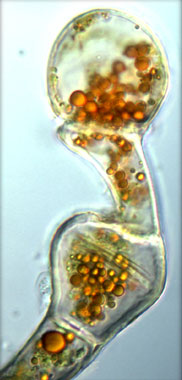
The subaerial habitat, although rich in other groups of organisms (i.e., bryophytes and fungi) in tropical and subtropical regions, has been long neglected by Phycologists, but represents a largely untapped new source of interesting and novel discoveries. A poorly known group of algae such as the Trentepohliales is in need of a higher degree of visibility in both the general and scientific literature. The general public is unaware of these organisms often living in their backyards, infecting their cultivars and ornamentals. Even scientists are usually unaware of this algal group; for example, Veralucia brasiliensis was erroneously described as a new genus and species based on a fungus from the Amazon in Brazil. This description was based on a “fungus-like alga,” later recognized as a member of the trentepohlialean species Cephaleuros parasiticus Karsten.
Recently we have published a modern review of the order Trentepohliales (Lopez-Bautista, Waters, & Chapman 2002). This publication is part of CONSTANCEA, the online continuation of the University of California Publications in Botany.This review is part of a special issue: Papers in Honor of the 80th Birthday of Paul Silva or FESTSCHRIFT. Please visit the website with the online publication of ”The Trentepohliales Revisited” or click above on Publications.
Another report (Lopez-Bautista & Chapman 2003) has been recently added on the Trentepohliales: we have analyzed nuclear-encoded small subunit rDNA sequences from several trentepohlialeans along with representatives all of the major lineages of green algae. Our analyses consistently indicated that the subaerial Trentepohliales are closely related to ulvophycean marine green algae, particularly to the siphonous and hemisiphonous orders. We also pointed out the presence of the phragmoplast-type cytokinesis in the Trentepohliales remains enigmatic, but it is interesting to note that this type of cell division is associated with terrestrial (subaerial) habitats! This report can be accessed from the Publications tab.
The last years have been significantly busy in our Trentepohlialean research, with several papers published or in process of publication. Here is a summary of our most current results:
In terms of the Systematics inside the order Trentepohliales we have been assembling a larger number of isolates representing several genera (Cephaleuros, Trentepohlia, Phycopeltis, Printzina, and Physolinum). Sequences for the 18S rDNA were obtained and phylogenetic analyses based on these sequences were compared with traditional system of classifiction based on morphological characters. Our results (Lopez-Bautista, Rindi & Guiry 2006) indicate that the morphological criteria used for the circumscription of genera and species of the Trentepohiales do not match phylogenetic patterns! Cephaleuros has resulted as a well-supported monophyletic clade, Trentepohlia is polyphyletic and strains of Trentepohlia, Phycopeltis,Printzina, and Physolinum are mixed together in several different lineages. We are currently including more taxa into this 18S rDNA database and sequencing the chloroplast-encoded rbcL to test these results (preliminary data are confirming the nuclear-encoded topologies).
These data are calling for a reassessment of the generic boundaries and a narrower circumscription of some genera (in particular Trentepohlia). At the same time, a closer analysis of the phylogenetic trees are indicating that some morphological characters, such as subcuticular habit, hetermorphic life history, and occurrence of zoosporangia in clusters, are shown to be phylogenetically informative! Whereas other characters commonly used for separation of species and genera (such as shape and size of cells, prostrate/erect habit, substratum colonized) have no phylogenetic relevance. Currently, we are using rbcL and ITS rDNA to look more carefully into the relationships inside genera and among species.

